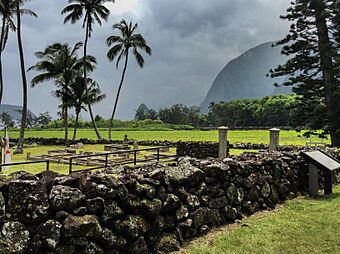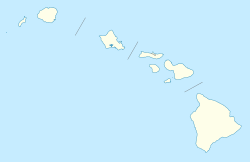Kalaupapa National Historical Park facts for kids
|
Kalaupapa Leprosy Settlement and National Historical Park
|
|

Kalaupapa National Historical Park, April 28-30, 2015
|
|
| Location | Kalaupapa, Molokaʻi, Hawaiʻi, USA |
|---|---|
| Area | 10,779 acres (4,362 ha) |
| Built | 1866 |
| Architect | Board of Health, Hawaii |
| Visitation | 58,875 (2012) |
| Website | Kalaupapa National Historical Park |
| NRHP reference No. | 76002145 |
Quick facts for kids Significant dates |
|
| Added to NRHP | January 7, 1976 |
| Designated NHLD | January 7, 1976 |
| Designated NHP | December 22, 1980 |
Kalaupapa National Historical Park is a special place in Kalaupapa, on the island of Molokaʻi in Hawaiʻi, USA. It was created in 1980 to protect the history and natural beauty of this area. For over a century, from 1866 to 1969, Kalaupapa was home to two settlements for people with leprosy, now known as Hansen's disease. More than 8,500 people lived here during that time. The park helps us remember their stories and the challenges they faced.
The rest of Molokaʻi island is home to over 7,300 people. This area was once used for cattle ranching and growing pineapples. Today, it is also a popular place for tourists to visit.
Contents
The History of Kalaupapa Peninsula
People have lived on the Kalaupapa peninsula for over 900 years. This was long before Europeans arrived in Hawaiʻi. Archeologists have found old house sites and farms. There are also irrigation systems, stone walls, and temples (heiau). These were all built by the ancient residents.
In the early 1800s, between 1,000 and 2,700 people lived here. But by 1853, only about 140 people remained. Many had died from diseases brought by visitors from other parts of the world.
The Kalaupapa Settlements for Hansen's Disease
In 1865, the government passed a law to stop the spread of leprosy. This disease, now called Hansen's disease, came to the islands around 1830. At that time, there was no cure for it.
The government decided to move Native Hawaiian people from Kalaupapa. They wanted to create a special place for people with severe Hansen's disease. This decision broke the deep connection these families had with their ʻāina (land). This connection had lasted for centuries.
Moving patients to these isolation settlements caused many problems for Hawaiian families. Many families were separated when a member got Hansen's disease. The governments of the Kingdom, and later the Territory and State of Hawaiʻi, tried to control the illness. They moved patients with serious symptoms to this isolated peninsula. Other patients were treated in quarantine on the main islands. But families were still broken up.
The first settlement was at Kalawao, on the windy side of the peninsula. Later, another was built at Kalaupapa. In 1890, about 1,100 people with Hansen's disease lived here. This was the most residents at one time. They often had to leave their families behind on other islands. The sadness of losing family members to Kalaupapa is still felt in Hawaiʻi today.
The settlements were managed by the Board of Health. A German immigrant named Rudolph Meyer helped control the money. Local leaders, some of whom were patients or their family members, supervised the settlements for many years.
Caring for the Residents
Many people helped care for those with Hansen's disease on Molokaʻi. Belgian missionary priests from the Congregation of the Sacred Hearts of Jesus and Mary were among them. The most famous was Father Damien. He served there from 1873 until he died in 1889. He was made a saint by the Roman Catholic Church in 2009.
Another important caregiver was Mother Marianne Cope. She was a nun and a hospital administrator from New York. In 1883, she brought six other nuns to Hawaiʻi. They helped care for people with Hansen's disease and improved medical facilities. Mother Marianne and her sisters built hospitals, homes, and schools on Oʻahu and Maui. In 1888, they moved to Kalaupapa. She lived and worked there until she died in 1918. She was also made a saint by the Catholic Church in 2012.
Brother Joseph Dutton also helped in the colony. He went to Molokaʻi in 1886 to help Father Damien, who was dying.
The Congregation of the Sacred Hearts continued to have brothers working on Molokaʻi. They helped the residents for many years. Since St. Marianne arrived in 1888, sixty-five Sisters of St. Francis have lived and worked in the settlement. Today, two Sisters still live at the Bishop Home. Mother Marianne started this home in 1888 to care for women and girls who were most vulnerable.
Life After a Cure
In 1873, scientists discovered that Hansen's disease was caused by a tiny germ called a bacterium. Since the 1940s, it has been curable with modern antibiotics. Today, no one living at Kalaupapa or on Molokaʻi has an active case of Hansen's disease.
After the National Park Service took over the settlement, former residents were allowed to stay. They and their families can continue to live in the homes on the peninsula if they choose.
What You Can See at the Park
Kalaupapa National Historical Park was created in 1980. It protects the historic settlements of Kalawao and Kalaupapa. The community of Kalaupapa is still home to a few elderly people who once had Hansen's disease. Some were changed by the illness before they were cured. They chose to stay in this peaceful place. They have shared their memories and experiences of their lives on the island.
At Kalawao, on the windy side of the peninsula, you can see two old churches. One is the Protestant church of Siloama, built in 1866. The other is Saint Philomena Catholic Church, which is connected to the work of St. Father Damien.


